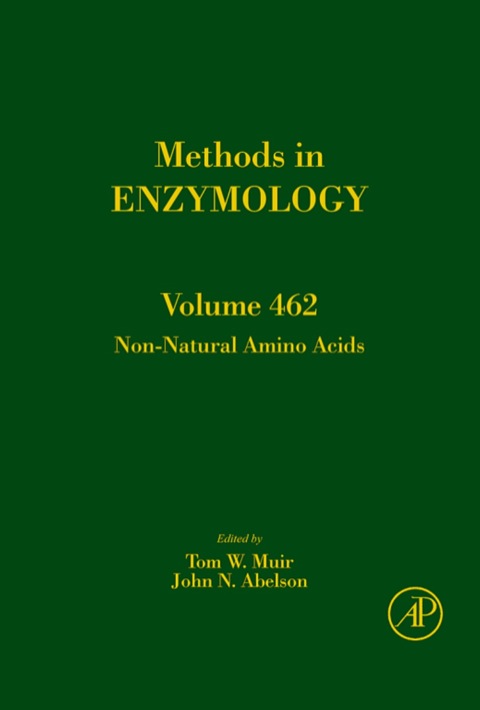Description
Efnisyfirlit
- Cover Image
- Table of Contents
- Preface
- Chapter 1 Protein Phosphorylation by Semisynthesis
- 1. Overview of Protein Phosphorylation
- 2. Investigating Protein Phosphorylation with Phosphomimetics
- 3. Phosphonate Analogues and Protein Semisynthesis
- 4. Methods
- 5. Practical Uses of Semisynthetic Phosphoproteins
- 6. Future of Protein Semisynthesis in Signaling
- Acknowledgments
- Chapter 2 Protein Engineering with the Traceless Staudinger Ligation
- 1. Introduction
- 2. Traceless Staudinger Ligation
- 3. Choice of Coupling Reagent
- 4. Preparation of the Azido Fragment
- 5. Preparation of the Phosphinothioester Fragment
- 6. Protein Assembly by Orthogonal Chemical Ligations
- 7. Prospectus
- Acknowledgments
- Chapter 3 Replacement of Y730 and Y731 in the α2 Subunit of Escherichia coli Ribonucleotide Reductase with 3‐Aminotyrosine using an Evolved Suppressor tRNA/tRNA‐Synthetase Pair
- 1. Introduction
- 2. Site‐Specific Insertion of Unnatural Amino Acids using the Suppressor tRNA/RS Method
- 3. NH2Y, a Y Analogue for Investigating Enzymatic PCET Reactions
- 4. Directed Evolution of NH2Y‐RS in E. coli
- 5. Examination of the Fidelity and Specificity of NH2Y Incorporation in a Protein Expressed in E. coli
- 6. Generation of Y730NH2Y‐α2 and Y731NH2Y‐α2
- 7. Characterization of NH2Y‐α2s
- 8. Summary
- Acknowledgements
- Chapter 4 Semisynthesis of Proteins Using Split Inteins
- 1. Introduction
- 2. Protein Splicing in cis and in trans is Performed by Inteins
- 3. Design of Split Inteins and Considerations on the Intein Insertion Site
- 4. Materials and Methods
- 5. Summary and Conclusion
- Acknowledgments
- Chapter 5 Expressed Protein Ligation for Metalloprotein Design and Engineering
- 1. Introduction
- 2. Methods of Selenocysteine Incorporation
- 3. Incorporation of Selenocysteine into the Type 1 Copper Site of Azurin
- 4. Tuning the Type 1 Copper Reduction Potential Using Isostructural Methionine Analogues
- 5. Conclusion
- Acknowledgments
- Chapter 6 Using Expressed Protein Ligation to Probe the Substrate Specificity of Lantibiotic Synthetases
- 1. Introduction
- 2. Use of Expressed Protein Ligation to Prepare Substrate Analogues
- 3. Conclusion
- Acknowledgments
- Chapter 7 Semisynthesis of K+ Channels
- 1. Introduction
- 2. Experimental Protocols
- 3. Application of Semisynthesis in Investigating the Selectivity Filter of the K+ Channels
- 4. Summary
- Acknowledgment
- Chapter 8 Segmental Isotopic Labeling of Proteins for Nuclear Magnetic Resonance
- 1. Introduction
- 2. Segmental Isotopic Labeling using Expressed Protein Ligation
- 3. Segmental Labeling using Protein Trans‐Splicing
- 4. Multiple Segment Assembly
- 5. Segmental Labeling of C‐Terminal SRC Kinase(Csk)
- Acknowledgments
- Chapter 9 Semisynthesis of Membrane‐Attached Prion Proteins
- 1. Introduction
- 2. Chemical Synthesis of Membrane Anchors
- 3. Semisynthesis of rPrPPalm by Expressed Protein Ligation
- 4. Semisynthesis of rPrPPalm by Protein Trans‐Splicing
- 5. Liposome Attachment and Aggregation of rPrPPalm and rPrPGPI
- 6. Conclusion
- Chapter 10 Use of Intein‐Mediated Protein Ligation Strategies for the Fabrication of Functional Protein Arrays
- 1. Introduction
- 2. Intein‐Mediated Protein Ligation Strategies
- 3. In Vitro, In Vivo and Cell Free Strategies for Protein Biotinylation at the C‐Terminal
- 4. Methods
- 5. Concluding Remarks
- Chapter 11 Semisynthesis of Ubiquitylated Proteins
- 1. Introduction
- 2. Semisynthesis of Ubiquitylated Histone H2B
- 3. Methods
- 4. Synthesis of Photocleavable Ligation Auxiliary
- 5. Peptide Synthesis
- 6. Generation of Recombinant Protein α‐Thioesters
- 7. Expressed Protein Ligation
- 8. Generation of Ubiquitylated Mononucleosomes
- 9. Conclusions
- Acknowledgments







Reviews
There are no reviews yet.